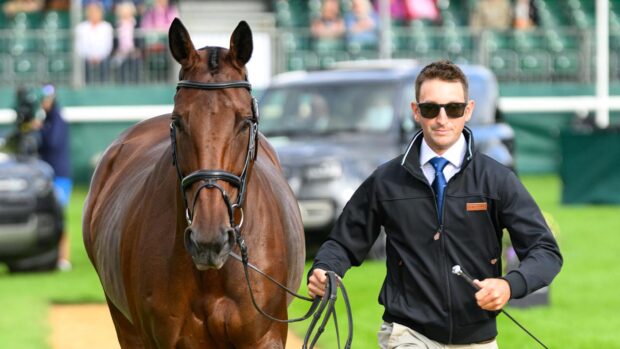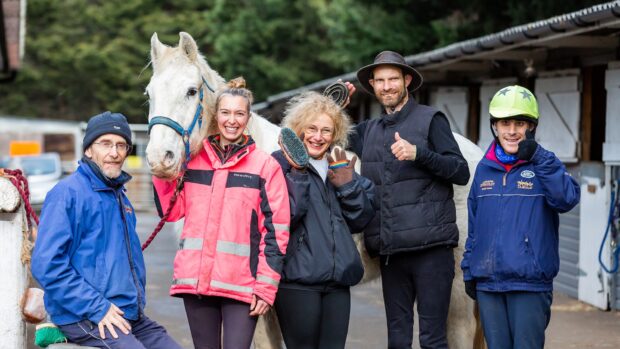A showjumper and his “trainer”, who used hind boots with “nails” inside on a horse then tried to cover it up, have been banned from the sport.
The FEI Tribunal has published its decision on Essam Zbibi, a British-registered rider based in the UAE, and Hicham Gharib, relating to abuse of HH Sigma at the CSI3* in Abu Dhabi on 25 February 2021.
The FEI said event officials reported that day, that Zbibi and Gharib had used hind boots with pins on HH Sigma.
Reports from four officials said a groom was seen “cautiously” putting a boot on the horse, his body angled away, then he “quickly pushed it down to the fetlock”. The steward said the horse’s reaction was “immediate and excessive”; lifting his leg and “shaking it several times”, then repeating.
The chief steward was called, during which time the groom was seen putting the second boot on HH Sigma, who displayed the same reactions. Zbibi got on and jumped fences “under the guidance of his trainer Hicham Gharib”. When the chief steward arrived, Gharib was seen taking the boots off and “running to the side of the warm-up” where he threw the boots “into the brush/shrub area”. The chief steward retrieved the boots, which each contained a “nail/sharp object” with “blood around the area”.
The chief steward reported it was “very clear and obvious” what had happened, and said when the horse’s hind legs were checked, it could be easily seen he was “still sore” and white cream had been applied to wounds. Zbibi did not initially deny that the boots were his and allowed photos to be taken. Zbibi and Gharib claimed to the officials they “did not know” [about the boots]. Zbibi was disqualified from the event and issued a yellow warning card. Gharib was told he would be reported to the FEI for horse abuse.
The FEI told the Tribunal it believed the boots were “constructed and designed in advance, showing intention and pre-planned abuse”. The main intention of the “pins” was to cause pain and unnecessary discomfort to the horse so he would lift his hind legs abnormally – and “win advantages in competition”. The FEI said the wounds on the horse’s legs and his reaction to the boots indicate they had been used before. FEI expert vets found there was “no doubt the respondents acted to cause pain and unnecessary discomfort to the horse”.
Representing himself, Zbibi said he was a “mere amateur rider” and had only been involved in FEI events for two years. He claimed he is “fond” of HH Sigma, whose health and wellbeing were his “main priority”. Zbibi said when he instructed his groom to tack up his horse he had “no idea” he would use the boots, adding that he had “never seen the boots before”. He fired the groom following the incident.
Zbibi said he accepted the yellow card at the time, but was not told there would be any further procedure for horse abuse. He claimed at the event and directly afterwards he had been “under constant pressure from FEI officials, and was not able to properly investigate the matter” until later. Zbibi said he spoke with the groom, who said he never put the boots on the horse.
Zbibi claimed Gharib was not his trainer and was at the event as a competitor, and he only asked him to take the boots off because he was unable to find his groom. He was “certain” the wrong boots were handed to officials, said the boots were not checked before or during the warm-up, and said a vet did not inspect the horse after the incident – and only the chief steward inspected the horse the following day. Zbibi claimed the marks on the horse were owing to a “history of allergy, which resulted in sudden and immediate limb sensitivity”.
Gharib denied all allegations – he said he entered the warm-up as a rider, not a trainer or support personnel. He removed the boots “as a favour” and could not recall seeing “nails or blood”. When shown the boots, he told officials they were not the ones he had removed. He added that the warm-up was busy, with accessories and equipment lying around near where the boots were found. Gharib said he had never been involved in any horse abuse, the wellbeing of horses has always been his priority, and the allegations could cause “irreparable harm”.
Gharib added that there had been “several procedural breaches” by FEI officials including that he did not receive a yellow card at the event and was not told of any violation, and that photos of HH Sigma were taken the next day and can not be relied upon as evidence. He contested the FEI expert vet report, and noted inconsistencies between officials describing the boots as having nails, but the expert report noting pins – “which are different in terms of effect, harm and size of the marks that would be caused”.
The Tribunal was “satisfied” the respondents committed horse abuse and their actions extended to “excessive discomfort”, and the horse was “clearly hurt and wounded”. Based on the expert vet reports, the Tribunal said the wounds indicated new and old injuries, from “repetitive use” of the boots.
The Tribunal was “not convinced” Zbibi did not know that the boots were put on his horse and that he had never seen them before. Based on the case material, the panel was “convinced” Gharib removed the boots and threw them away in “an attempt to hide the reprehensible behaviour”. The Tribunal believed Gharib “assisted and encouraged” the horse abuse committed by Zbibi, and his attempt to throw away the boots constituted a “separate and clear breach” by trying to “cover up” the violation.
The Tribunal found Zbibi’s behaviour amounted to “clear abuse” and “maltreatment”.
“These are among the most severe offences that can be committed in the context of equestrian sport,” read the decision, adding that Zbibi’s actions were “intentional, deliberate and premeditated”, and he showed “no signs of remorse”.
In mitigation, the panel noted, to its knowledge, Zbibi and Gharib had never before been sanctioned for disciplinary offences in equestrian sport.
Zbibi was suspended for four years from the date of the decision, fined 10,000 CHF (£7,969), and must pay 2,000 CHF (£1,593) costs. Gharib was suspended for one year, fined 5,000 CHF (£3,984) and 2,000 CHF costs. The respondents can appeal to the Court of Arbitration for Sport within 21 days.
The full Tribunal decision can be read here.
You might also be interested in:

‘A clear case of horse abuse’: showjumper banned for using ‘spiked’ hind boots

Top rider’s 10-year ban for ‘deliberate, methodical and repetitive’ electric spur use
The rider said he intends to appeal immediately to the Court of Arbitration for Sport.

Subscribe to Horse & Hound magazine today – and enjoy unlimited website access all year round
Horse & Hound magazine, out every Thursday, is packed with all the latest news and reports, as well as interviews, specials, nostalgia, vet and training advice. Find how you can enjoy the magazine delivered to your door every week, plus options to upgrade your subscription to access our online service that brings you breaking news and reports as well as other benefits.




